Science Highlights, June 27, 2018
Awards and Recognition








- Mike Prime earns Society of Experimental Mechanics (SEM) award
- Hanna Makaruk recognized as a New Mexico STEM Woman of the Year
- Rian Bahran wins Asian American Most Promising Engineer of the Year Award
- Yongchao Yang awarded the Lab’s first Publication Prize in the Engineering Sciences
- Orion Staples receives American Chemical Society’s Undergraduate Research Award
- Avadh Saxena inducted as Affiliate Professor at the Royal Institute of Technology, Sweden
- Rohit Prasankumar elected secretary-treasurer of an American Physical Society division
- Alan Perelson to be honored as the Josiah Willard Gibbs Lecturer in 2019
Capability Enhancement
New shock physics research facility opens
Cleanroom upgraded for unclassified research
Confocal microscope provides innovative diagnostic tools
Contact-free neuroimaging microscope images the structure of materials
Methods developed to image the Earth’s subsurface with cosmic rays and gravity
Ultracold Neutron Facility upgrade may aid sensitivity for the neutron electron dipole moment
Materials Physics and Applications
First measurement identifies the exciton mass in a new class of 2-D semiconductors
Materials Science and Technology
Model explains sink density in non-equilibrium chemical redistribution in binary alloys
Awards and Recognition
Mike Prime earns Society of Experimental Mechanics (SEM) award
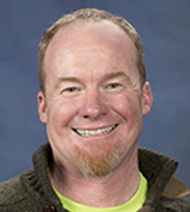
Mike Prime
The Society of Experimental Mechanics (SEM) has chosen Mike Prime (Advanced Engineering Analysis, W-13) to receive the Felix Zandman Award. The award recognizes individuals who have made significant contributions to the development of measurements or applications using photoelastic coatings or strain measurement techniques.
Prime received a Ph.D. in mechanical engineering from the University of California – Berkeley, where he had a National Defense Science and Engineering Graduate Fellowship. He joined the Lab more than 20 years ago. His work focuses on nonlinear vibrations, structural health monitoring, residual stress measurement, shock physics and material failure at very high strain rates. Prime invented the contour method for residual stress measurement, which aerospace and nuclear power industries use. Alcoa and Boeing have licensed the invention, and startup companies in California and the United Kingdom have used it. His publications have over 9000 citations, and Prime has delivered plenary keynote lectures at several international conferences. Prime is an ASME Fellow. He co-founded the Residual Stress Summit and has served as an Associate Technical Editor for Experimental Mechanics. Other awards include the A. J. Durelli award from the SEM, 8 NNSA Defense Program Awards of Excellence, and 4 Laboratory Distinguished Performance Awards.
The Society for Experimental Mechanics is a professional organization for engineers and scientists studying the design and implementation of experiments to characterize materials, structures, and systems. Technical contact: Mike Prime
Hanna Makaruk recognized as a New Mexico STEM Woman of the Year
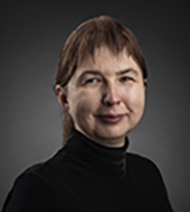
Hanna Makaruk
The New Mexico Supercomputer Challenge has selected Hanna Makaruk (Applied Modern Physics, P-21) as a New Mexico STEM 2018 Woman of the Year. She is among a dozen honorees who were chosen for “the grace and grit at which they pursue life and career” and who are featured in the 2018 “New Mexico Women in STEM” calendar. The calendar is sent to math and science teachers throughout the state to highlight successful women in STEM.
Makaruk earned a Ph.D. in applied science from the Polish Academy of Sciences. She joined the Lab as a Director’s Postdoctoral Fellow in 1996. In her research in image and experimental data analysis at the Laboratory, she has authored more than 40 open scientific publications and book chapters and nearly 200 LANL classified reports. Makaruk is a data validation and archiving project leader. For 15 years she has volunteered with the Institute of Electrical and Electronics Engineers and for nearly two decades has organized American Mathematical Society sectional meetings.
Founded in 1990, the Supercomputing Challenge is a nonprofit educational organization that sponsors an annual computational science competition for middle and high school students in New Mexico. The competition is designed to interest students in science, technology, engineering, and math (STEM) fields and to promote networking between local tech firms and students.
The calendar, which is available for purchase, was also sponsored by the Albert I. Pierce Foundation, DataONE, EPSCoR, Lodestar Reinsurance, University of New Mexico, and private donations. Technical contact: Hanna Makaruk
Rian Bahran wins Asian American Most Promising Engineer of the Year Award
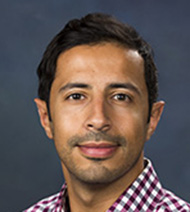
Rian Bahran
Rian Bahran (Advanced Nuclear Technology, NEN-2), has received the 2018 Asian American Most Promising Engineer of the Year Award. He is recognized for “leading the development of transformative nuclear engineering and technology solutions to the ever-increasing dynamic threats of nuclear proliferation and nuclear terrorism while simultaneously integrating vital aspects of next-generation human capital development into these technical efforts.”
The Asian American Engineer of the Year (AAEOY) Executive Committee, which represents the Chinese Institute of Engineers–USA, recognized Bahran and other honorees at its 17th annual AAEOY Award Ceremony on April 7 in Albuquerque, NM.
Bahran earned a Ph.D. in nuclear science and engineering from Rensselaer Polytechnic Institute. He joined Los Alamos in 2013 as a postdoctoral researcher. As a nuclear engineer, Bahran leads research and training efforts in nuclear proliferation, safeguards, security and criticality safety. He is part of NEN-2’s Critical Experiments Team-2, which is designing a unique benchmark experiment with kilogram quantities of neptunium. The experimental results of this benchmark at Nevada’s National Criticality Experiments Research Center will validate predictive computational radiation transport methods and their underlying nuclear data.
In another project, Bahran and colleagues are analyzing results from a first-of-a-kind measurement performed in situ at a research reactor. They aim to observe neutron clustering experimentally. Los Alamos collaborates with France’s Institute for Radiological Protection and Nuclear Safety on this experiment. Simulation have shown that neutrons would not be evenly dispersed at very low power levels in a critical system, inducing the formation of clusters. Clustering has never been experimentally observed in a nuclear system, although similar phenomena have been observed in other fields. Technical contact: Rian Bahran
Yongchao Yang awarded the Lab’s first Publication Prize in the Engineering Sciences
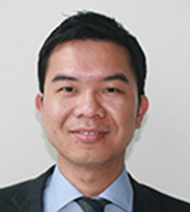
Yongchao Yang
The 2017 Postdoc Engineering Publication Prize was awarded to previous Director’s Postdoctoral Fellow, Yongchao Yang (Engineering Institute of the National Security Education Center, EI/NSEC), for his paper entitled “Blind Identification of Full-Field Vibration Modes from Video Measurements with Phase-Based Video Motion Magnification” published in Mechanical Systems and Signal Processing.
This paper was created entirely during Yang’s Director’s Funded Postdoctoral appointment at the Engineering Institute. The publication reports the development of a novel video-processing algorithm to extract high-resolution full-field structural mode shapes using only a video of a structure when it is vibrating in the plane of the captured image. The algorithm can identify modal damping ratios, natural frequencies, and modal responses. The video processing algorithm is a form of unsupervised learning. The algorithm can extract these characteristics of structural dynamics without human intervention. It should work with any form of video-like sequences of images from any type of imager. It is anticipated that it will be applicable at any length and time scale that can be captured by an imager. This technique might be used to identify the structural dynamics of everything from the changes in cytoskeletal stiffness that occur when a biological cell becomes cancerous to the structural dynamics of an entire planet as measured using an imager mounted on a spacecraft.
Reference: “Blind Identification of Full-Field Vibration Modes from Video Measurements with Phase-Based Video Motion Magnification,” Mechanical Systems and Signal Processing 85, 567 (2017); https://doi.org/10.1016/j.ymssp.2016.08.041 Authors: Yongchao Yang (National Security Education Center, Engineering Institute, NSEC/EI and currently Argonne National Laboratory), Charles Dorn (University of Wisconsin), Tyler Mancini (University of Texas – Austin), Zachary Talken (Missouri University of Science and Technology), Garrett Kenyon (Applied Modern Physics, Charles Farrar and David Mascareñas (NSEC/EI).
Yang received a PhD. in civil engineering at Rice University. He is currently a staff member at Argonne National Laboratory.
Mary and Richard Mah created and funded this new prize, which is administered through the Laboratory’s Postdoctoral Program Office. After a career spanning thirty-one years, Richard Mah retired from LANL as the Associate Director for Weapons Engineering and Manufacturing (ADWEM).
This annual prize recognizes a single publication that describes high-impact innovative research in Engineering Science. Engineering Science refers to the development of new hardware or software tools that allow engineers to better analyze, design, operate, control and/or maintain existing systems or develop the next generation of engineered systems with advanced performance capabilities. Publications that describe the development of new engineering tools, either through the novel integration of existing technologies or the development of completely new capabilities, are appropriate for this prize. The publication should describe work performed primarily during the author’s Laboratory postdoctoral appointment. Former postdoctoral appointees are eligible for the prize, regardless of present position (internal or external to the Lab). Technical contact: Mary Anne With
Orion Staples receives American Chemical Society’s Undergraduate Research Award
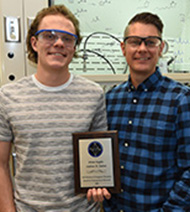
Photo. Orion Staples (left) and Andy Sutton were jointly honored with the ACS Undergraduate Research Award as student and preceptor.
Orion Staples (Inorganic, Isotope, and Actinide Chemistry, C-IIAC) received the American Chemical Society Division of Inorganic Chemistry Undergraduate Research Award. This award recognizes the collaborative research of an outstanding North American undergraduate student and her or his preceptor in the field of inorganic chemistry. His mentor Andy Sutton (C-IIAC) was also honored as preceptor. Staples received $1,000 and a plaque. Sutton, as his mentor, will receive a plaque for permanent display at the Lab. The award ceremony was held at the Spring 2018 National ACS Meeting in New Orleans, which took place on March 18th.
Staples was selected for this award for his exemplary contributions to research projects in the group during the summer of 2017. His initial work supported an externally funded project through DOE Energy Efficiency and Renewable Energy’s BioEnergy Technology Office to develop new fuels and chemicals derived from biomass. The research supports the Lab’s Energy Security mission area and the Materials for the Future science pillar.
Prior to his arrival the team used acetone as a bio-derived building block to produce commodity fuels and chemicals. Staples saw the potential for this type of chemical application and focused on using ethanol instead of acetone. He developed a method that dehydrogenates ethanol to acetaldehyde. Subtle changes in the reaction conditions can make diesel, gasoline, and commodity chemicals. His new reaction scheme dramatically increased yields, and he performed more than 100 reactions with full analysis while learning new spectroscopic techniques. A patent application and a paper in the journal Green Chemistry included his work.
Staples also won a 2017 Distinguished Student Award from the Lab. He graduated from the University of New Mexico in December and is currently a post baccalaureate student at Los Alamos. Staples will enter the graduate program at the University of Pennsylvania in July. Technical contact: Andy Sutton
Avadh Saxena inducted as Affiliate Professor at the Royal Institute of Technology, Sweden
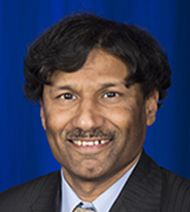
Avadh Saxena
The Royal Institute of Technology in Stockholm, Sweden (KTH) has granted the title of Affiliate Professor to Avadh Saxena, Group Leader of T-4 (Physics of Condensed Matter and Complex Systems). In this role, Saxena will spend a few weeks every year at the Institute collaborating with faculty and students as well as fostering broader interactions between European researchers and the Laboratory. This prestigious award was bestowed upon only five people in all fields of research from around the world this year. Saxena was honored for his numerous, original contributions to theoretical physics.
The induction ceremony took place at the Concert Hall in Stockholm and was followed by an elaborate banquet and ball at the City Hall—the same two venues where Nobel Prizes are awarded every year on December 10.
Saxena has been involved with the Laboratory since 1990, when he worked at the Lab as a consultant/visiting scientist after completing a Ph.D. in Physics from Temple University. In 1993, Saxena became a Technical Staff Member. His research includes structural phase transformations, nonlinear excitations, optical, electronic, vibrational, transport and magnetic properties of functional materials, device physics, soft condensed matter and interplay of nonlinearity, geometry and topology.
Saxena a Fellow of the American Physical Society and the Laboratory for his foundational contributions to phase transitions in functional materials and nonlinear excitations in low-dimensional electronic materials. He is an affiliate of the Center for Nonlinear Studies and a member of the Sigma Xi Scientific Research Society. His early work on skyrmions was in the Discovery News and NBC News in 2013. He has published more than 400 papers and edited five books on these topics. In addition to his research at the Lab, he has worked as an adjunct professor at the University of Barcelona, Spain, the University of Arizona, Tucson and Virginia Tech. Saxena has also served as science advisor for the National Institute for Materials Science, Tsukuba, Japan.
The Royal Institute of Technology (KTH) in Stockholm, Sweden is a university founded in 1827 upon the Laboratorium Mechanicum, which was itself founded in 1697 as a place of study for the research and teaching of mechanics. The Laboratorium Mechanicum was created by Christopher Polhem, who is known as the father of mechanics in Sweden. Currently, KTH is ranked 33rd worldwide as a university of engineering and technology. Technical contact: Avadh Saxena
Rohit Prasankumar elected secretary-treasurer of an American Physical Society division
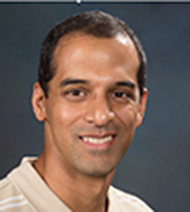
Rohit Prasankumar
The American Physical Society’s (APS) Division of Laser Science has chosen Rohit Prasankumar (Center for Integrated Nanotechnologies, MPA-CINT) as secretary-treasurer. The division promotes laser science interests within the APS and other societies and sponsors numerous awards, conferences, and educational programs. As secretary-treasurer, Prasankumar will serve through October 2020 and be responsible for maintaining the records and funds in the division.
Prasankumar earned a Ph.D. in electrical engineering from the Massachusetts Institute of Technology. He joined the Laboratory as a postdoctoral researcher with CINT’s Laboratory for Ultrafast Materials and Optical Science team and became a staff member in 2006. CINT is a DOE Office of Basic Energy Sciences national user facility jointly operated by Sandia National Laboratories and Los Alamos National Laboratory.
Prasankumar oversees two optical laboratories at CINT, where he pursues research at the intersection of ultrafast laser science, condensed matter physics, and nanotechnology. He investigates ultrafast dynamics and phenomena in complex quantum materials from terahertz to x-ray frequencies. Prasankumar has published more than 50 peer-reviewed articles and has more than 1500 citations. His research supports the Lab’s Energy Security mission area and the Materials for the Future science pillar by advancing research for controlled functionality and by examining the properties of quantum materials.
The American Physical Society is a non-profit membership organization working to advance and disseminate the knowledge of physics through its research journals, scientific meetings, and education, outreach, advocacy and international activities. APS represents more than 53,000 members, including physicists in academia, national laboratories and industry around the world. Technical contact: Rohit Prasankumar
Alan Perelson to be honored as the Josiah Willard Gibbs Lecturer in 2019
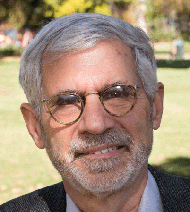
Alan Perelson
The American Mathematical Society (AMS) has selected Alan Perelson (Theoretical Biology and Biophysics, T-6) as the lecturer for the Josiah Willard Gibbs Lectureship in 2019. This prestigious honor is by invitation only. Former lecturers include Nobel prize winners, National Academy members, and distinguished scientists such as Albert Einstein, Vannevar Bush, Theodore von Karman, John von Neumann, Subrahmanyan Chandrasekhar, Hermann Weyl, G.E. Uhlenbeck, and Kurt Godel. Perelson plans to present on “Immunology for Mathematicians,” with a focus of Immunology and Infectious Disease Modeling for Mathematicians.
The Josiah Willard Gibbs Lecture was established in 1923 by Gibbs, a mathematical physicist. He intended to inform both the public and academic communities of current mathematic contributions to society. The prize is awarded annually not only to mathematicians, but also to chemists, physicians, biologists, and other scientists whose work has contributed to modern civilization, generally through mathematics or its applications.
Perelson received a Ph.D. in biophysics from the University of California - Berkeley. He joined the Laboratory in 1974 as a staff member in the Theoretic Biology and Biophysics. Perelson’s research focuses on understanding how the immune system protects the body from infectious disease such as HIV, HCV and influenza. His work modeling the effects of drug therapy has contributed to an understanding of HIV infection and the need to treat HIV with a combination therapy and has been fundamental in understanding principles that have contributed to the cure for hepatitis C infections. He has published more than 500 articles and has over 45,000 citations. Perelson has received the National Institute of Health’s MERIT Award, and a place on the Thomson Reuters list of “The World's Most Influential Scientific Minds.” The APS has recognized him with the Max Delbruck Prize in Biological Physics—a prize that recognizes outstanding achievements in biological physics research. The prize cited him for “profound contributions to theoretical immunology, which bring insight and save lives.” He is a member of the American Academy of Arts and Sciences, the Society for Industrial and Applied Mathematics, and the American Physical Society. Perelson is a Fellow of the American Association for the Advancement of Science, Los Alamos National Laboratory, and is one of seven senior Fellows serving at the Lab.
Perelson served as Group Leader for the Theoretical Biology and Biophysics Group at the Lab from 1995-2001. He has appointments as an adjunct professor of Bioinformatics at Boston University, adjunct professor of Biology at the University of New Mexico, and adjunct professor of Biostatistics and Computational Biology at the University of Rochester Medical School.
The National Institutes of Health has funded his research, which supports the Laboratory’s Global Security mission area and the Information, Science, and Technology science pillar. Technical contact: Alan Perelson
Capability Enhancement
New shock physics research facility opens
The Dynamic Equation-of-State (DEOS) facility at TA-40 relocates legacy capabilities that have supported the weapons program at the Lab for more than half a century. The modernization and consolidation of these capabilities is key to maintain one of the nation’s signature shock physics programs.
Scientists study the evolution of shock waves as they propagate through a material to learn how materials fail or “break,” to understand how materials transform from one phase to another at pressure (melting, freezing, etc.), or to generate conditions that are comparable to those found inside the planets. Essential to understanding these phenomena is knowledge of a materials equation-of-state (EOS) that defines the relationship between the pressure, temperature, and volume (or density) for a material. This information is essential for simulating the response of matter under extreme conditions.
These “extreme” states of matter, found in nature as meteorite impacts or within the Earth’s core, can be created in the laboratory using explosive and gun systems. Well-defined shock waves are formed when a projectile impacts a material creating a high-pressure state in very short time scales, typically within nanoseconds, or a billionth of a second. The new DEOS facility brings four gun systems to a single location: the legacy high-performance 2-stage gun that has operated at the Lab since the 1960s, a 40-mm and a 90-mm single stage powder gun, and a 50-mm gas gun spanning impact velocities from 0.1 to 8 km/s to generate impact stress in the multi-megabar range.
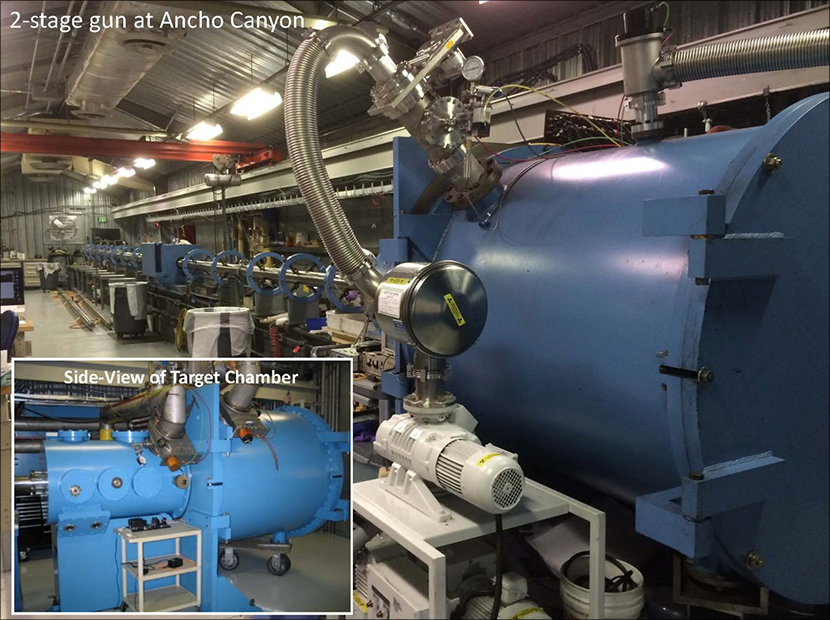
Photo. The high-performance 2-stage gun currently located at Ancho canyon. At over 70 feet long, the 2-stage gun can reach velocities up to 7-8 km/s for shock wave experiments on materials. The gun was built by General Motors in the 1960s and used for more than 2000 shock wave experiments since its installation. This 2-stage gun will be modernized and relocated to the new DEOS facility. (Inset) Side-view of the catch can and target chamber showing the barrel extending into the target chamber where the impact event occurs.
The DEOS facility will play a central role in dynamic compression science at the laboratory and across the country. The DEOS team also operates the 40-mm gun at LANSCE (TA-53) for proton radiography, the 40-mm gun at TA-55 to study hazardous materials including plutonium, a 12-mm gun at the Advanced Photon Source (Argonne, IL) known as IMPULSE, and routinely conducts explosive loading experiments at firing sites. The Shock and Detonation Physics Group (M-9) conducts hundreds of experiments each year in support of programs including the NNSA Science Campaigns, DOE/DoD Joint Munitions Program, Global Security, and for external customers such as Livermore National laboratory.
DEOS is a new construction project in the NNSA’s effort to modernize the nation’s nuclear weapons enterprise infrastructure. NA-522, Office of Infrastructure Operations and Modernization, funded the capability, which supports the Lab’s Nuclear Deterrence and Global Security mission areas and the Materials for the Future and Science of Signature science pillars.
The need for shock physics data is growing, for both national security and global security applications. The research informs a number of models used in support of NNSA’s Science Campaign and Directed Stockpile Work programs, the DOE/Department of Defense Joint Munitions Program, as well as the Department of Homeland Security and other agencies.
Los Alamos is a leader in the field of shock physics, with more American Physical Society fellows nominated by the Topical Group of Shock Compression and Condensed Matter than the rest of the DOE complex combined. Now the researchers will continue their work at a modern facility which brings together multiple gun systems in a gun room (5,550 square feet) supported by an adjacent control/diagnostics room (2,268 square feet). Both rooms are separated by a modern blast wall and door that protect the researchers from the impact events. DEOS is located at TA-40 near M-9’s other dynamic compression capabilities allowing LANL to reduce programmatic and operational costs, increasing efficiency and productivity, reduce the facility footprint at the laboratory, and minimizes the management span of control.DEOS will be equipped with the latest experimental controls and diagnostic, telecommunications, network, and electrical and mechanical systems including a 4-ton overhead crane spanning the length of the building, laboratory compressed air and nitrogen, a modernized hydrogen handling system for the 2-stage gun, on-site explosive magazines for temporary staging, and a complete machine shop and experiment assembly areas. The DEOS team bring up the facility in a 3-year phased approach that will minimize down time of the capabilities currently in Ancho Canyon beginning in 2018 with the 40-mm powder gun and ending with the commissioning of the 2-stage gun in 2020. Technical contact: Brian Jensen
Cleanroom upgraded for unclassified research
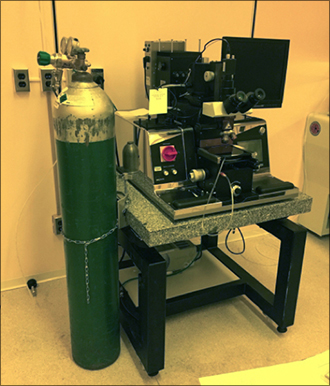
Photo. A Karl Suss MJB3 mask aligner for photolithography. This system can accommodate photomasks up to four inches and create patterns with a resolution of 500 nm.
Equipped with state-of-the-art micro- and nano-fabrication equipment, newly upgraded, unclassified, certified ISO class 3 and class 4 cleanrooms are available at the Laboratory. Operated by the Materials Physics and Applications Division (MPA), the facility caters to research and development that calls for a clean, controlled environment.
Located in Technical Area 3, SM-40, which is in the open security environment, the facility offers easy access and a variety of tools to accommodate diverse research needs, from a mask aligner to vapor deposition to a wire bonder and, soon, systems for reactive ion etching and plasma-assisted atomic layer deposition. The facility’s flexible nature and new equipment make it useful for the Lab’s programmatic needs, including prototype device fabrication at small scales.
Key to a cleanroom’s operation is the filtration system, which recirculates air, minimizing potential contaminants that could prove detrimental during device preparation. The new class 3 cleanroom has fewer than 1,000 particles larger than 0.1 µm per cubic meter, while the two ISO class 4 rooms can have a maximum of such 10,000 particles per cubic meter. In comparison, the air we breathe may have as many as 35,000,000 particles per cubic meter that are 0.5 µm or larger. The facility is not bound to a specific certification process or designed for a particular research topic, which is especially advantageous to one-off users who want to research and develop devices.
Group Leader Andrew Dattelbaum (Materials Synthesis and Integrated Devices, MPA-11) headed the facility’s refurbishment, along with Abul Azad and Jinkyoung Yoo (Center for Integrated Nanotechnologies, MPA-CINT), and Chris Romero (MPA-11), who provided equipment acquisition and installation support. Romero is point of contact for daily operations, and will help organize scheduling, training, and work execution for interested users. The Center for Integrated Nanotechnologies (CINT), a DOE Office of Science User Facility, is helping support the cleanroom facility. Scientists interested in using the facility can potentially get free access to its capabilities through the CINT user program. Contact A. Azad (MPA-CINT) for more information about accessing the facility through CINT.
Laboratory Institutional Support funded the cleanroom refurbishment. Technical contact: Andrew Dattelbaum
Confocal microscope provides innovative diagnostic tools
The Chemical Diagnostics and Engineering group (C-CDE) has acquired a Keyence VHX-6000, an all-in-one confocal microscope that incorporates observation, high-resolution image capture, and measurement capabilities. Its features include 3-D visualization of surfaces, real-time non-contact measurements, multi-angle observations, real-time depth composition, multi lightning and polarization filters and advanced analysis software to quantify morphological features. The team has developed a strong expertise in using this capability for fundamental science and programmatic applications, including the following:
- The team established a fast and reliable quality inspection technique to detect flawed Bi2Te3 wafers used in radioisotope thermoelectric generators (RTG) in partnership with the acoustics and sensors team in Materials Synthesis and Integrated Devices (MPA-11). Acoustic excitation is very sensitive to small changes in the material, but it is not capable of correlating the response signal to the physical and mechanical state of the wafer. Data from the new confocal microscope enabled linking the mechanical and microstructural state of the wafer to the acoustic response. This joint approach provided a robust capability to discriminate between “good” vs. “bad” wafers.
- Confocal microscopy examined the combined effects of ionizing radiation and thermal treatments on the aging of siloxane foams containing small amounts of carbon nanofibers. These fibers improve the strength of the porous microstructure of foams. Microscopy of accelerated aged foams enabled monitoring the microstructure changes of pore size, shape, and distribution within the foam and provided valuable information regarding the foam’s long-term durability.
- Researchers use this microscope to provide quality control in additive manufacturing (AM) research. The microscope inspects polymer pads fabricated using the direct ink writing technique to evaluate the integrity of the printed 3-D structure. The technique has enabled development of novel polymeric resins for AM.
- The microscope supports a LDRD-ER project investigating the chemical and biological mechanisms underlying the formation of manganese oxide-rich rock varnish in arid environments worldwide. Researchers aim to identify signatures that can distinguish abiotic and biotic mechanisms of rock varnish formation and how these signatures can be used to determine the origin of manganese oxides observed on surface rocks of Mars. Confocal microscopy examines the influence of rock microtopography on varnish formation and the co-localization of microcolonial fungal colonies, lichens and varnish. This information is critical for evaluations at the micron and nanometer scale.
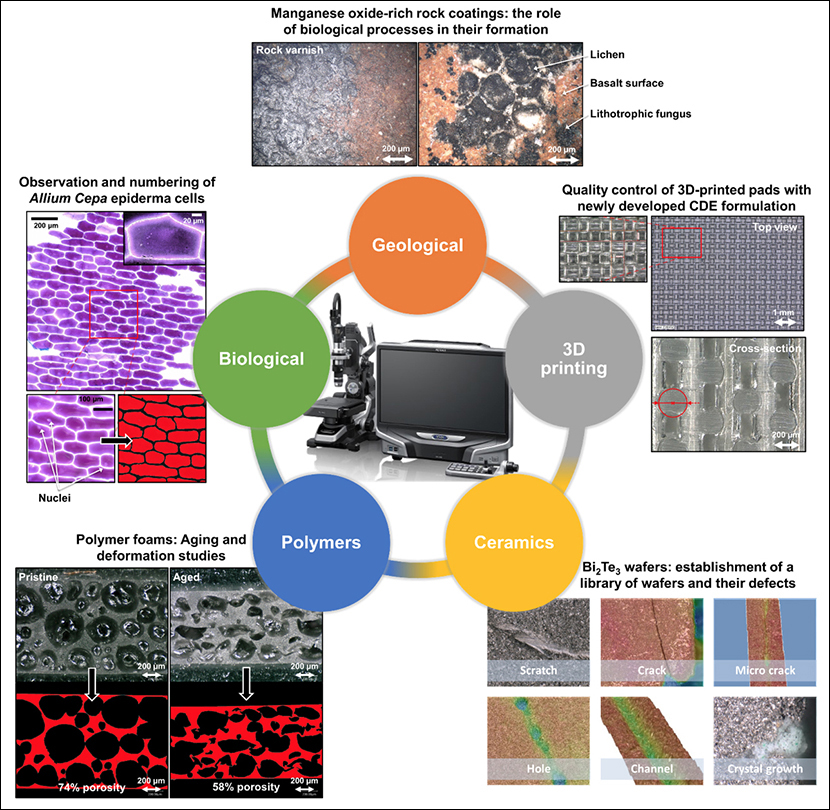
Figure. Applications of the confocal microscope.
Researchers: Joseph H. Dumont, Shaylynn Crum, Chris Yeager, Kwan-Soo Lee, and Andrea Labouriau (C-CDE). The NNSA Enhanced Surveillance Campaign funded the instrument, which supports the Nuclear Deterrence mission area and the Materials for the Future science pillar. Technical contact: Andrea Labouriau
Contact-free neuroimaging microscope images the structure of materials
Decades of research have been dedicated to improving contact-free neuroimaging techniques that allow users to image neurons in the brain. Recently, Anatoly Efimov and Evan Perillo (Center for Integrated Nanotechnologies, MPA-CINT) have developed an advanced microscopy system that visualizes materials’ internal and surface structure through nonlinear-optical interaction induced by external lasers. The unique system provides multiple image contrast mechanisms, including sensitivity to vibrational resonances and quasi-static electric fields in the sample. This capability, combined with the expertise of CINT scientists, could offer novel modalities for sample imaging and diagnostics in biology, chemistry, and materials sciences for CINT users.
Efimov and Perillo designed the microscope to send femtosecond laser pulses to a sample in the mid-infrared frequency range, enabling users to probe both transparent and opaque materials. The tool can use both laser scanning and sample scanning to obtain the image. Because the excitation path of the microscope is all-reflective, there are no issues with attenuation, dispersion, and chromatic aberrations typical for standard refractive microscopes. Photon counting detectors are used for extremely low light levels typically encountered in nonlinear imaging modalities. The microscope can accommodate electrical and electrophysiology probes for sample connectivity. Available image contrasts include multiple-photon fluorescence, vibrationally resonant harmonic and sum-frequency generation, and coherent and stimulated Raman processes. The lasers’ wavelengths can be tuned continuously in the 1-5 micrometer range, letting the user target vibrational resonances in molecules and enhance specific nonlinear interactions. Excitation lasers can be temporally synchronized and variably delayed to enable pump-probe interrogation of the sample and allow for time-based image contrast, such as lifetime and delayed response.
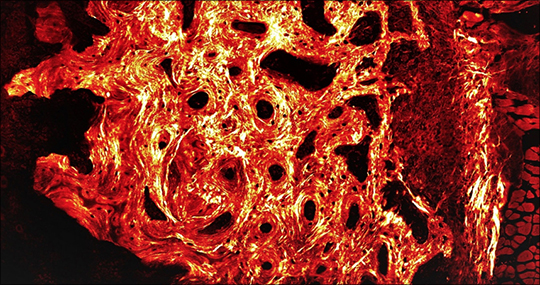
Figure. An image of mammalian compact bone taken by the new neuroimaging microscope. The signal originates from second harmonic generation of collagen within the osteons of the bone. Image size is 0.75 mm by 1 mm.
The instrument was designed and built with funding from a Laboratory Directed Research and Development (LDRD) project titled “Sensitive Optical Super-Resolution Neuroimaging,” which aims to image the quasi-DC electric field of the neuronal action potential. Such chemical imaging of live neurons yields an intrinsic high-contrast signal that lets users study high-speed firing events in large groups of neurons. In a broader scope, the system could be used to image electric fields in materials and samples relevant to the Laboratory’s Science of Signatures and Materials for the Future science pillars. The work supports the Laboratory’s Energy Security and Global Security mission areas.
Efimov and Perillo are preparing the instrument for use in the lab. They plan to continue testing the microscope’s sensitivity limits to the DC electric field using lithography-manufactured non-biological samples and to explore lateral resolution limits, field of view extents, and imaging speeds. The pair conducts baseline experiments with simple biological samples to reproduce past results from literature.
CINT is a DOE Office of Basic Energy Sciences user facility operated by Sandia National Laboratories and Los Alamos National Laboratory that offers access to a unique combination of expertise and equipment for nanoscale science research center. Technical contact: Anatoly Efimov
Methods developed to image the Earth’s subsurface with cosmic rays and gravity
Imaging shallow underground features in three dimensions (3-D) is an important goal in a variety of applications, including hydrogeology and assessment of seismic and volcanic hazards. Researchers in the Earth & Environmental Science (EES) and Physics (P) divisions collaborated with the University of New Mexico and Pacific Northwest National Laboratory to use a uniquely well-characterized rock volume on the Los Alamos town site mesa to assess multiple methods for imaging subsurface targets and to develop a prototype detector for subsurface imaging.
The team used a tunnel the Lab’s TA-41 site to image the overlying Bandelier Tuff with 1) underground cosmic ray muon tomography, and 2) surface and subsurface gravity measurements. Researchers used these two measures of density structure, along with prior geologic observations, to build 3-D models of the subsurface from each of the independent datasets (muon and gravity) and from the datasets combined.
The interactions of cosmic rays with nuclei present in the atmosphere produce particles called cosmic ray muons. Muon tomography takes advantage of these naturally produced particles to estimate the density of the objects they pass through. Passing through matter reduces the flux of cosmic ray muons. Density can be calculated based on the reduction in flux relative to background rates.
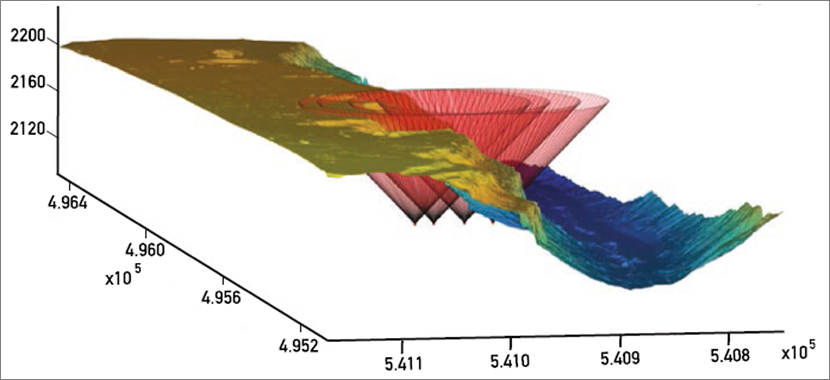
Figure 1. Muon detector acceptance limits (red cones) for 4 detector positions in the tunnel, view along strike of canyon.
The model developed from the muon flux dataset agreed well with known topography from remotely sensed Light Detection and Ranging (LIDAR) observations (Figure), demonstrating the power of cosmic ray muons to image shallow geological targets.
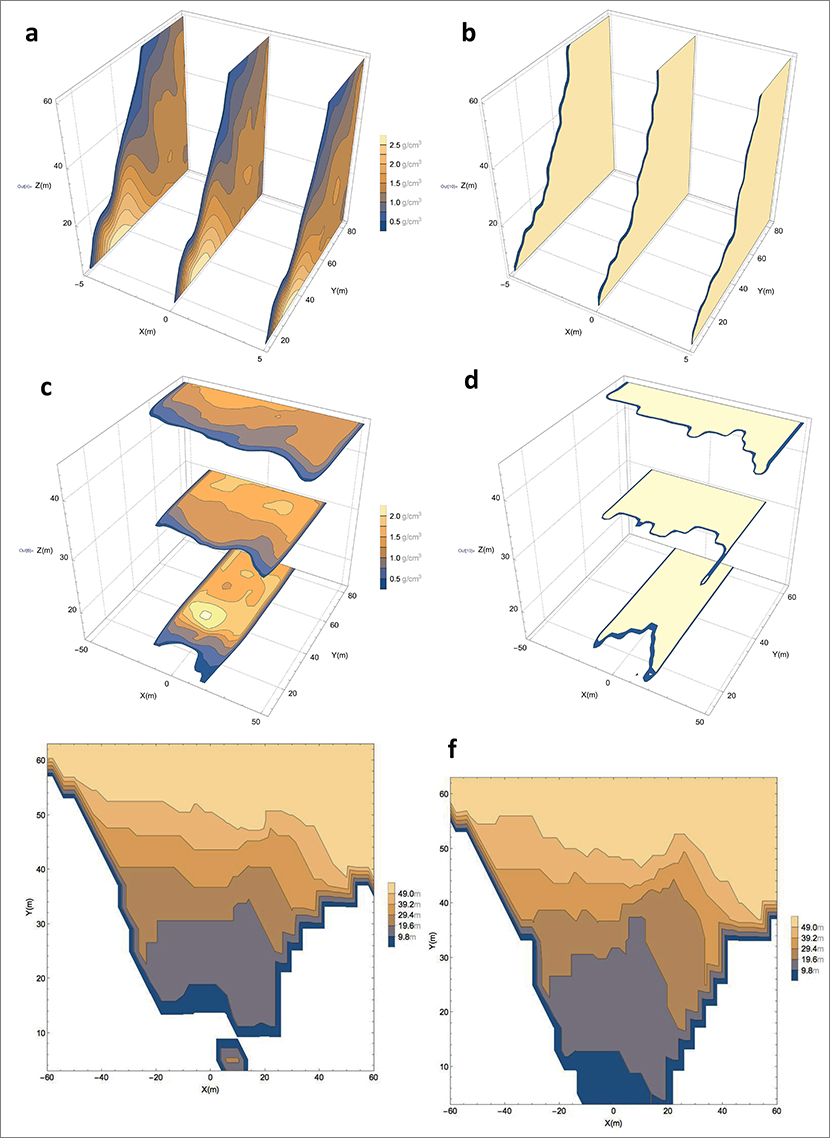
Figure. Muon tomography results (left; a,c,e) and comparison to Light Detection and Ranging (LIDAR) rock/air interface (right; b,d,f). Areas outside detector’s acceptance are not shown. a, b Vertical cross sections through model and LIDAR, respectively. c, d Horizontal sections through model and LIDAR, respectively. e, f Model estimation, and LIDAR validation, respectively, for topographic elevation contours in map view.
Density can also be calculated from gravity measurements by isolating the effects of density on gravity through subtraction of other well-constrained gravitational effects, including latitude, elevation, and topography. The gravity density modeling exercise indicated that both surface and subsurface gravity data were required, along with relevant geologic constraints, to accurately estimate structure using gravity alone (Figure). Use of the joint datasets resulted in a more precise and stable 3-D model of the subsurface than either dataset alone.
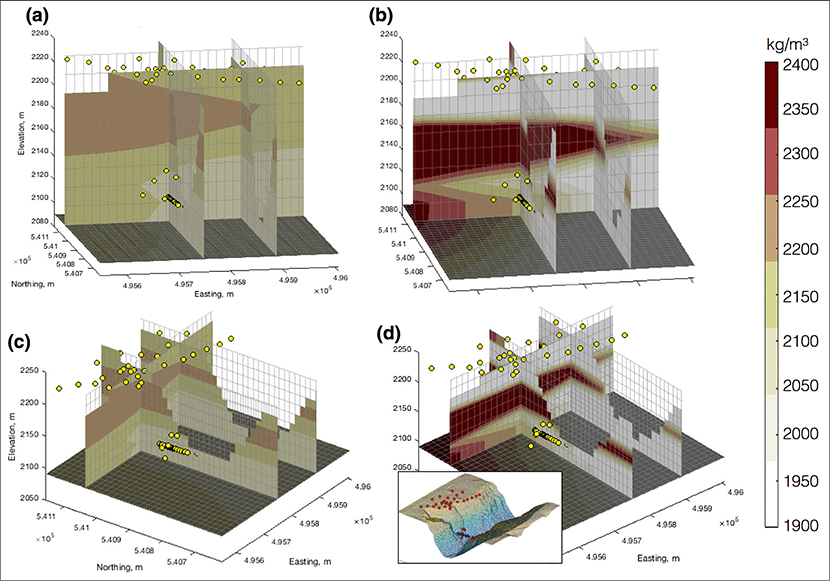
Figure. Gravity model results with station locations (yellow dots) using (a) a spatially uniform starting guess; (b) a geology-based starting guess. Panels (c) and (d) show different perspectives of the models in (a) and (b), respectively. Both starting models produce similar results, benefiting from the in-tunnel data. For reference, the inset shows station locations (red dots) on the rendered topographic surface.
In a related project, Los Alamos researchers collaborated with Pacific Northwest National Laboratory to develop a smaller, borehole-capable muon detector, offering far more flexibility in the variety of possible targets for underground imaging. The teams tested the prototype in the tunnel alongside Los Alamos’s much larger Mini Muon Tracker (MMT) and found that its results agreed well with those measured with the MMT, though with somewhat lower resolution. This work demonstrates the power of combined muon and gravity data sets to image shallow geological targets using underground detectors.
References: “3D Cosmic Ray Muon Tomography from an Underground Tunnel,” Pure and Applied Geophysics 174, 2133 (2017); doi:10.1007/s00024-017-1526-x. Authors: Elena Guardincerri (Subatomic Physics, P-25), Charlotte Rowe (Geophysics, EES-17), Emily Schultz-Fellenz (Earth System Observations, EES-14), Mousumi Roy (University of New Mexico), Nicolas George (University of New Mexico), Christopher Morris (P-25), Jeffrey Bacon (P-25), Matthew Durham (P-25), Deborah Morley (formerly P-25, retired) Kenie Plaud-Ramos (former student P-25) Daniel Poulson (P-25), Diane Baker (EES-17), Alain Bonneville (Pacific Northwest National Laboratory), Richard Kouzes (Pacific Northwest National Laboratory).
Inferring Shallow Subsurface Density Structure from Surface and Underground Gravity Measurements: Calibrating Models for Relatively Undeformed Volcanic Strata at the Jemez Volcanic Field, New Mexico, USA.” 2017. Pure and Applied Geophysics 175, 1003 (2018); https://doi.org/10.1007/s00024-017-1742-4. Authors: Mousumi Roy, Megan Lewis, Alex Johnson, and Nicolas George (University of New Mexico); Charlotte Rowe (Geophysics, EES-17); and Elena Guardincerri (Subatomic Physics, P-25).
Seminar: “Probing the Los Alamos Town Site Mesa with Cosmic Rays and Gravity,” GEO University Project Report Seminar hosted by CSES, January, 2018. Authors: Elena Guardincerri (P-25), Charlotte Rowe (EES-17), and Mousumi Roy (University of New Mexico).
The DOE Subsurface Science and Technology, Research and Energy Development (SubTER) program and a grant from the Los Alamos National Laboratory Center for Space and Earth Sciences (CSES) funded different aspects of the Los Alamos work. This work supports the Lab’s Nuclear Deterrence, Global Security, and Energy Security mission areas; and the Science of Signatures science pillar through developments in passive geophysical imaging. Technical contact: Char Rowe
Ultracold Neutron Facility upgrade may aid sensitivity for the neutron electron dipole moment
Los Alamos researchers and their collaborators executed a major upgrade to the ultracold neutron (UCN) source at the Los Alamos Neutron Science Center (LANSCE). The improvements enable a more sensitive search for the neutron electric dipole moment (nEDM). Scientists have searched for this particle physics signature for nearly 60 years. Confirming its existence could explain the apparent imbalance of matter and antimatter in the universe.
The lack of sufficiently strong sources of UCNs has hampered search efforts worldwide. Evaluations indicated an upgrade of the Los Alamos source would provide the necessary UCN density for such an experiment with the required sensitivity.
The LANSCE linear accelerator Ultracold Neutron Facility’s source produces high-energy spallation neutrons. The Ultracold Neutron Facility’s uses solid deuterium to cool the neutrons by one million billion-fold. It is the first production UCN source based on superthermal UCN production and the only operational source of UCNs in the United States. Successfully operated for over a decade, the facility has been instrumental to numerous fundamental particle physics experiments, providing UCNs to the UCNA, UCNB, and UCNτ studies and to development work for the nEDM and Nab experiments at Oak Ridge National Laboratory’s Spallation Neutron Source.

Figure. Schematic of the Los Alamos Ultracold Neutron Facility at LANSCE. Part of the biological shield is removed in this illustration to show the ultracold neutron (UCN) source and guides.
The work to upgrade the source started in 2014, and included replacing the horizontal UCN guide and designing and replacing a cryostat insert that maximized the stored UCN density in the nEDM cell at the planned experiment location. Experimental and theoretical research has resulted in a prototype nEDM experimental apparatus and improved UCN density. Measurements indicate that the source performs as modeled, producing a UCN density at the exit of the biological shield that is a fourfold increase from the highest previously reported. The improvements enable the UCNτ experiment to collect data sufficient for a 1-s statistical uncertainty in the free neutron lifetime in an actual running time of approximately 60 hours.
When the researchers take into account the nominal LANSCE accelerator running schedule and assumed data-taking efficiency of 50%, they estimate that the required sensitivity for an nEDM experiment could be achieved in five years or less. The upgraded source will enable other UCN-based experiments, such as improved measurements of the neutron β asymmetry.
Researchers: T. M. Ito, S. M. Clayton, S. Currie, D. E. Fellers, S. MacDonald, M. Makela, C. L. Morris, R. W. Pattie, Jr., J. C. Ramsey, A. Saunders, Z. Tang, and H. L. Weaver (Subatomic Physics, P-25); S. Sjue (Applied Modern Physics, P-21); W. Wei (Computational Physics, CCS-2); E. R. Adamek, N. B. Callahan, and D. J. Salvat (Indiana University, Bloomington); J. H. Choi and A. R. Young (North Carolina State University); C. Cude-Woods (P-25 and North Carolina State University); X. Ding (Virginia Polytechnic Institute and State University); P. Geltenbort (Institut Laue-Langevin, France); S. K. Lamoreaux (Yale University); C.-Y. Liu (P-25 and Indiana University, Bloomington); E. I. Sharapov (Joint Institute of Nuclear Research, Russia); and A. P. Sprow (University of Kentucky). Eric Brosha (Materials Synthesis and Integrated Devices, MPA-11) and other researchers helped the team characterize a coating, while Michael Mocko (LANSCE Weapons Physics, P-27) assisted them in the use of a computer cluster.
The Laboratory Directed Research and Development (LDRD) Program funded the work, which supports the Lab’s Energy Security mission area and its Nuclear and Particle Futures and Science of Signatures science pillars by aiding the development of expertise and capabilities required for its national security science missions. LANSCE, an accelerator-based national user facility for national security research and fundamental science, is principally sponsored by the National Nuclear Security Administration. Technical contact: Takeyasu Ito
Chemistry
Engineered quantum dots developed for double-pane solar windows
In work reported in Nature Photonics, the Laboratory’s Quantum Dot team has demonstrated advances in luminescent solar concentrators (LSCs). The researchers used two types of “designer” quantum dots to create double-pane solar windows that generate electricity in each pane. The new window architecture uses two different layers of low-cost quantum dots tuned to absorb different parts of the solar spectrum.
These quantum-dot-based double-pane windows and other more complex luminescent solar concentrators offer a way to decrease the cost of solar electricity by using low-cost, solution-processable materials. The approach complements existing photovoltaic technology by adding high-efficiency sunlight collectors to existing solar panels or integrating them as semitransparent windows into a building’s architecture.
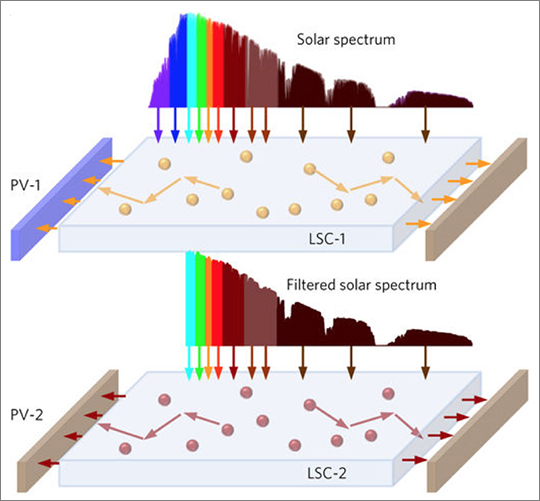
Figure. A short-wavelength portion of the solar spectrum is absorbed by the luminescent solar concentrator’s (LSC’s) first layer (LSC-1), and the re-emitted light (orange arrows) is guided towards edge-mounted PVs. The longer-wavelength portion of the solar spectrum transmitted through LSC-1 is collected by LSC-2, which is equipped with its own set of PVs. For the best performance, this scheme should utilize bandgap-matched solar cells (PV-1 and PV-2).
The key to this advance is “solar-spectrum splitting,” which allows one to process separately higher– and lower–energy solar photons. The higher-energy photons can generate a higher photovoltage, which could boost the overall power output. This approach also improves the photocurrent because the dots used in the front layer are virtually “reabsorption free.”
To achieve this, the Los Alamos team incorporates into quantum dots ions of manganese that serve as highly emissive impurities. Light absorbed by the quantum dots activates these impurities. Following activation, the manganese ions emit light at energies below the quantum-dot absorption onset. This trick allows for almost complete elimination of losses due to self-absorption by the quantum dots.
To transform a window into a tandem luminescent sunlight collector, the Los Alamos team deposits a layer of highly emissive manganese-doped quantum dots onto the surface of the front glass pane and a layer of copper indium selenide quantum dots onto the surface of the back pane. The front layer absorbs the blue and ultraviolet portions of the solar spectrum, while the rest of the spectrum is picked up by the bottom layer.
Following absorption, the dot re-emits a photon at a longer wavelength, and then the re-emitted light is guided by total internal reflection to the glass edges of the window. There, solar cells integrated into the window frame collect the light and convert it to electricity.
If the per square meter cost of a luminescent solar concentrator is much lower than that of a photovoltaic module, then this scheme could enable a reduction in the cost of solar electricity. luminescent solar concentrators technology may also allow new types of device such as semitransparent solar windows and solar sidings, lightweight optical antennas for space applications, and spectral reshapers for applications in photobiology and photochemistry.
Reference: “Tandem Luminescent Solar Concentrators Based on Engineered Quantum Dots,” Nature Photonics 12, 105 (2018); doi: 10.1038/s41566-017-0070-7. Authors: Kaifeng Wu, Hongbo Li, and Victor I. Klimov (Physical Chemistry and Applied Spectroscopy, C-PCS).
The Center for Advanced Solar Photophysics (CASP), an Energy Frontier Research Center funded by the DOE, Office of Science, Basic Energy Sciences sponsored the work. Wu received a Laboratory Director’s Postdoctoral Fellowship. The research supports the Lab’s Energy Security mission area and the Materials for the Future science pillar through the development of materials for solar energy harvesting and conversion to electrical power. Technical contact: Victor Klimov
Earth and Environmental Sciences
Carbon cycle response to El Niño warming investigated
The El Niño-Southern Oscillation (ENSO) is a natural warming and cooling of the tropical Pacific Ocean that occurs every three to seven years. It is one of the largest modes of climate variability, with major impacts on the global carbon cycle and implications for temperature and rainfall in many parts of the world. Changes in global climate may influence the generation, and temporal and spatial characteristics of El Niños. However, there are still uncertainties regarding the frequency and behavior of El Niños under various climate scenarios. Atmospheric carbon dioxide (CO2) concentrations rise from anthropogenic emissions and their increase has been identified as the primary driver of global warming. However, half of the CO2 emitted by humans is soaked up by the oceans and the terrestrial biosphere, moderating its atmospheric rise and causing it to vary year to year. The temperature increase associated with El Niños promote CO2 outgassing from oceans and releases by vegetation, soils and fires, particularly in the tropics, suppressing the natural CO2 sinks. Therefore, atmospheric concentration of CO2 increases by larger amounts during El Niño years, but this amount can vary significantly for different El Niños.
Previous research investigating the amount of atmospheric CO2 increase due to El Niño events has assumed only a single type of El Niño. However, recent studies have differentiated two types of El Niño (Figure 1a) based on where warming originates: Eastern Pacific El Niños (EP El Niños) originating in the Eastern Tropical Pacific, and Central Pacific El Niños (CP El Niños) originating in the Central Tropical Pacific. These two El Niño types have contrasting impacts on different regions of the globe with alternate consequences for temperature and precipitation. Researcher led by the Lab’s Earth System Observations Group (EES-14), in collaboration with colleagues at National Oceanic and Atmospheric Administration (NOAA) and University of Alabama, published the first paper investigating similarities and differences in carbon cycle response to strong El Niño events between the two El Niño types. The journal Environmental Research Letters has reported their findings.
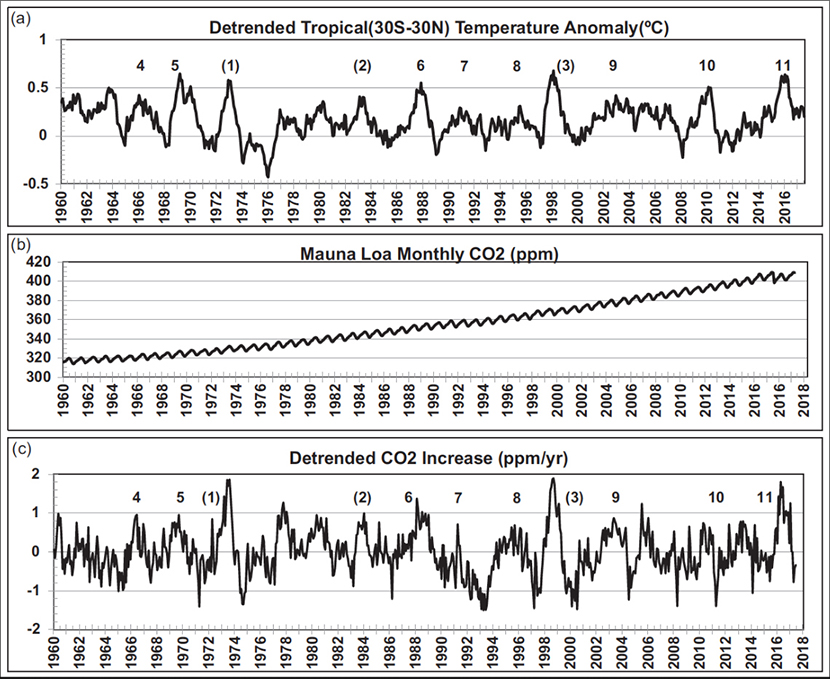
Figure. (a) Monthly tropical (30◦S−30◦N) temperature anomaly using data from the UK Meteorological Office. Numbers indicate the CP El Niños and numbers in parenthesis the EP El Niños. (b) Monthly atmospheric CO2 concentration record from Mauna Loa Observatory. (c) Differentiated CO2 anomaly record from Mauna Loa Observatory. All anomalies are with respect to the 1960–2016 mean. The time series are de-trended with the mean set to zero.
Researchers found that the response of atmospheric CO2 concentration to El Niño warming is about the same in both El Niño types: an increase of about 3 ppm of atmospheric CO2 per year and 1 oC of tropical temperature increase (Figure 2c). However, the time of the peak CO2 response to initial warming varies significantly for the two El Niño types. The average time lag of the CP El Niño is 4.0±1.7 months, while the mean time lag of EP El Niño is 8.5±2.3 months (Figure 2d). This difference in time lags may be due to contrasting regional vegetation responses, including fires associated with regionally drier CP El Niños (shorter time lag), and changes in respiration associated with regionally wetter EP El Niños (longer time lag).
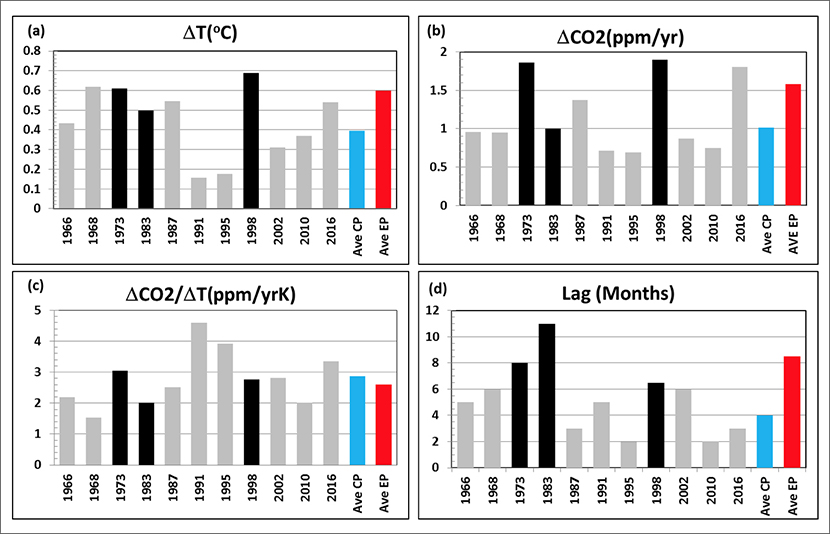
Figure. (a) The tropical temperature increase (ΔT) during the individual El Niño events. Gray columns denote the CP (Central Pacific) and the black columns EP (Eastern Pacific) El Niños. The red and blue columns are corresponding averages over all EP and CP El Niños. (b) The corresponding increases in CO2 growth rate. (c) The temperature/CO2 feedback, ΔCO2/ΔT, for individual El Niños and their averages. (d) Time lags for individual El Niño events and their averages.
These results indicate that CO2 responds to temperature increase indirectly through other climate related processes (e.g., vegetation and oceans) that should be included in climate simulations. The enhanced understanding of the carbon cycle gained through this analysis will help to constrain future versions of climate models.
Reference: “The Carbon Cycle Response to Two El Niño Types: an Observational Study,” Environmental Research Letters 13, 024001 (2018); https://doi.org/10.1088/1748-9326/aa9c5b. Authors: Petr Chylek (Earth System Observations, EES-14 and New Mexico State University), Pieter Tans (NOAA), John Christy (University of Alabama), and Manvendra K Dubey (EES-14).
The Department of Energy, Office of Science, Office of Biological and Environmental Research, Climate and Environmental Sciences Division, Terrestrial Ecosystem Science Program funded the work. The research supports the Laboratory’s Energy Security mission area and Science of Signatures science pillar through enhanced insight into the relationship of El Niños and the carbon cycle. Technical contacts: Peter Chylek and Manvendra Dubey
Intelligence and Space Research
Long-range wireless sensor network developed for harsh environments
Collecting years of data can be the key to meaningful scientific research, a thriving business, or better security. When the research involves recording data in the subfreezing temperatures of the Arctic or a business requires tracking pasture conditions over an expansive and remote cattle ranch, today’s indoor data-collecting sensor networks are not up to the job. They cannot handle harsh outdoor environments or vast distances. Jan Frigo (Space Data Science and Systems, ISR-3) has led a team of researchers at Los Alamos National Laboratory and West Virginia University to develop the Long-range Wireless Sensor Network to meet these challenges.
Wireless sensor networks in the past were developed for indoor applications and were not suitable for vast outdoor extreme environments. They were expensive to deploy and maintain, required specialized programming skills, and the networks were unreliable and difficult to manage due to the large routing paths required to support such a system. Current solutions have been restricted to outdoor networks covering smaller geographic areas (e.g., 1 sq. km). Using longer range radios to make routing paths smaller in length requires high transmit power supported by large, bulky batteries. Therefore, a new strategy was needed.
The Long-range Wireless Network Sensor grew out of the Laboratory’s decades of experience in developing rugged, low-power satellite components for the remote and harsh environment of space. The Lab has applied this expertise to create novel long-range wireless sensor networks for harsh environments and low resource situations on Earth.
The team found that Commercial-Off-The-Shelf (COTS) parts did not meet their needs because the hardware architecture was not designed for scientific computing and did not enable communications protocols that could navigate long range over diverse terrain. Therefore, the researchers have designed and built their own custom hardware and software. The investigators have developed an extremely flexible node as the basic building block of the network. Modern System on a Chip design enables energy efficient computing, generic ports for sensors, dual communications (satellite or radio), with flexibility that allows the team to optimize the node design for their applications. The easily deployed nodes act as data collecting, processing, and transfer points. Scientists can connect any type of sensor depending on what they want to monitor.
Collaborator Vinod Kulathumani (West Virginia University) developed the Periodic Fresh Tree Protocol algorithm to enable the nodes to cover large areas, use little resources, and enable the nodes to discover a multi-hop path to the master node without any manual configuration or intervention. If a node fails or is removed, other nodes will discover alternate paths around it to the master node. The self-healing feature enables maintenance of uninterrupted service in remote, harsh environments. The master node sends data to the host computer via Ethernet, serial, wireless, or satellite communication interface, enabling data transmission from virtually anywhere on Earth.
The Long-range Wireless Sensor Network easily, efficiently, and affordably collects, processes, and transmits data in all kinds of rugged and remote outdoor environments — areas with few roads, little to no infrastructure, no electricity or cellphone service, and extremely cold or hot temperatures. The researchers have already demonstrated continuous operation of the sensor network in remote areas for up to five years, operational temperatures from -40 oC to 85 oC, ability to process raw data before transmission, low power requirements (milliWatts continuous or microWatts in sleep mode), and scaling to 120-200 nodes. More information: https://youtu.be/zuUvhtl-YVQ
In one application of the invention, researchers are monitoring a remote and rugged canyon watershed in northern New Mexico. The network has 150 field-deployable, temperature-resistant nodes spread out across the rugged Pajarito Plateau. Scientists are analyzing the chemical composition of the runoff water. Instead of manually checking 150 locations, they rely on the network to tell them when to collect samples. When water is detected, the sensors trigger a robot that pumps storm-water runoff into bottles. Researchers can monitor the entire network remotely from a computer screen in near-real time. When scientists see on the computer that bottles have filled at a particular location, they can then go to the physical location, collect the bottles, and analyze them — saving time and money with fewer trips and reducing risk to employees who must retrieve samples in inclement weather.
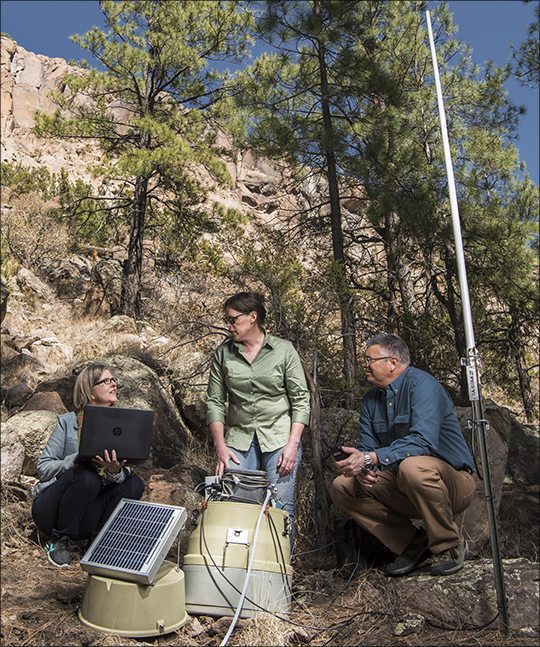
Photo. (Left to right): Janette Frigo, Alex Saari, and Jim Krone configure a Stormwater Runoff sensor node in the field.
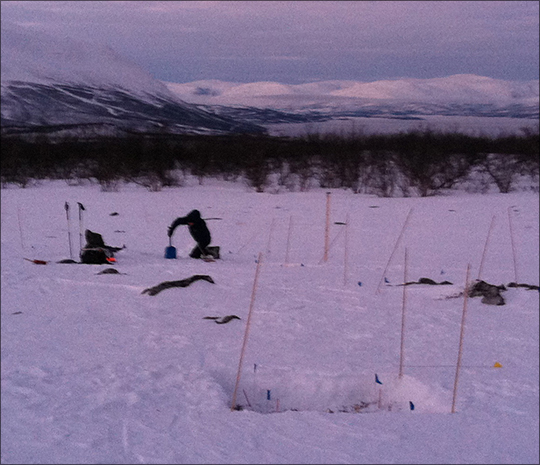
Photo. Researchers used the Long-range wireless network sensors in Abisko, Sweden. The photo shows Adam Collins (EES-14) working in the field. Photo courtesy Turin Dickman (EES-14).
Earth System Observations (EES-14) scientists used the invention in collaboration with the Norwegian Institute for Nature Research (NINA) to investigate the impact of snow cover change on sub-Arctic tundra vegetation. They connected their sensors to the system for 24/7 monitoring and transmission near Abisko Station, Sweden in the Arctic Circle. That system operated continuously for over 2-years with temperatures as low as -25 oC/-13 F.
Researchers: Janette Frigo, Tracy Gambill, James Krone, Hudson Ayers, Shawn Hinzey, Kari Sentz, and Xiaoguang Yang (Space Data Science and Systems, ISR-3); Terra Shepherd (ISR-4); Richard Dutch, Louis Borges, Bobby Quintana, Ryan Hemphill (ISR-5); Michael Cai (ISR-DO); Sanna Sevanto, Cathy Wilson, Joel Rowland, and Thom Rahn (Earth System Observations, EES-14); Kevin McCabe, Don Enemark, Michael Proicou, and David Guenther (X-Theoretical Design, XTD-DO); Stephen Judd (XTD Integrated Design & Assessment, XTD-IDA); Armand Groffman, Alexandra Saari, Steven Veenis, Allison Chan (formerly ER Environmental Services, currently N3B); Bobbie Rappe (MOF-CM-STR); Tom Dufresne (formerly LANL); and Vinod Kulathumani (West Virginia University).
The Laboratory Directed Research and Development (LDRD) program originally funded the development of the Long Range WSN. The DOE Office of Science, DOE Environmental Management, and LDRD sponsored different applications of the work. This research supports the Lab’s Global Security mission area and the Science of Signatures and Information Science and Technology science pillars. The work promotes data at scale and multi-source integration for forward deployment, and adaptive sensing systems for national security signatures. Technical contact: Jan Frigo
Materials Physics and Applications
First measurement identifies the exciton mass in a new class of 2-D semiconductors
Los Alamos researchers and collaborators have reported the first direct measurement of the mass of the fundamental particles in an atomically thin semiconductor by using high magnetic fields. The results are important not only as a guide to theoretical models but also to the widely anticipated rational design and engineering of future ultrathin, lightweight, and efficient optoelectronic devices based on this new class of two-dimensional semiconductors. The journal Physical Review Letters published the research as an “Editor’s Suggestion.”
The team used the high magnetic fields at the National High Magnetic Field Laboratory-Pulsed Field Facility (NHMFL-PFF) at Los Alamos to measure the optical spectrum of a single monolayer of tungsten diselenide (WSe2), an archetypal member of the recently discovered class of atomically thin semiconductors known as the transition-metal dichalcogenides. The researchers directly measured the mass of the material’s fundamental optical excitation—an electron-hole pair, or “exciton.” In all semiconductors, excitons play an essential role in technological applications such as solar cells or light-emitting diodes. An exciton has a certain weight, or mass, that influences most aspects of device performance. Therefore, understanding its specific mass is critical to modeling and developing devices. The team used the NHMFL-PFF’s 65-T capacitor-driven pulsed magnet to perform these measurements. Scientists positioned single monolayers of high-quality WSe2 over the tips of single-mode optical fibers to ensure a rigid alignment between the optical path and the small monolayer crystals that is immune to the vibrations that are otherwise inherent in pulsed-magnet experiments. The research provided robust measurement of the exciton’s mass for the first time in this new class of 2-D semiconductors. Understanding this fundamental material parameter could be key to developing a new generation of ultrathin, lightweight, and efficient optoelectronic devices.
Figure. (Top left): Notional schematic of the 1s, 2s, 3s, and 4s Rydberg states of an exciton in the monolayer semiconductor WSe2, which researchers measured using circularly polarized optical spectroscopy in pulsed magnetic fields. (Top right): optical transmission spectra at selected magnetic fields. Blue and red correspond to right- and left-circularly polarized light. (Bottom): An intensity plot of the optical transmission spectra, as a function of photon energy (horizontal axis) and magnetic field (vertical axis). The energy shifts of the 1s, 2s, 3s, and 4s Rydberg states are clearly visible.
Reference: “Magneto-Optics of Exciton Rydberg States in a Monolayer Semiconductor,” Physical Review Letters 120, 057405 (2018). doi: 10.1103/PhysRevLett.120.057405. Authors: Andreas V. Stier (formerly National High Magnetic Field Laboratory, MPA-MAG now Plasma Physics, P-24), Kirill A. Velizhanin (Physics and Chemistry of Materials, T-1), Nathan P. Wilson and Xiaodong Xu (University of Washington), Junichiro Kono (Rice University), and Scott A. Crooker (MPA-MAG).
The National Science Foundation, the DOE Office of Science, Basic Energy Sciences; and the State of Florida funded the Los Alamos portion of the research. The study supports the Laboratory’s Energy Security mission area and its Materials for the Future science pillar –Emergent Phenomena science theme by providing experimental measurements of fundamental material parameters. Such measurements could aid the development of materials with predictable performance and controlled functionality for useful applications. Technical contact: Scott Crooker
Materials Science and Technology
Model explains sink density in non-equilibrium chemical redistribution in binary alloys
Los Alamos researchers and collaborators have developed a model to predict the effects of irradiation on chemical redistribution in nuclear materials as a function of the number of interfaces in the material. Such a redistribution leads to changes in the structural properties of the material, potentially driving the system to failure. Chemical redistribution might lead to irradiation-assisted stress corrosion cracking and irradiation-accelerated corrosion, which represent major concerns as material failure mechanisms for current and future nuclear reactor components. The journal Physical Review Letters published the research.
Interfaces, the boundaries in a material’s microstructure between different crystals, are sinks (an absorbing mechanism) for extra atoms or missing atoms, and therefore reduce the accumulation of radiation damage. However, they are themselves the source of radiation-induced segregation, which can lead to a material’s breakdown. During radiation-induced segregation, those defects pull solute atoms—atoms added to enhance the properties of the metal—to the interfaces or away from them, changing the local composition and potentially the properties of the material.
The investigators used kinetic Monte Carlo simulations and an analytic treatment to show and explain how interfaces can mitigate radiation-induced segregation—specifically that increasing the density of interfaces reduces radiation-induced segregation. This model provides new insight into the design of microstructures that mitigate chemical redistribution and improve radiation tolerance of materials used in the extreme environments of nuclear energy systems.
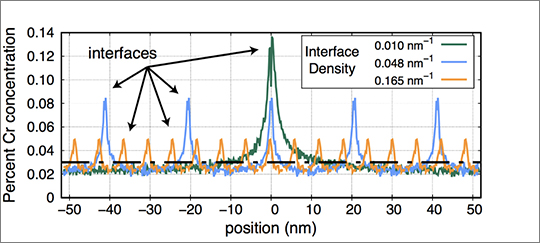
Figure. Kinetic Monte Carlo simulations reveal that increasing the density of interfaces in an Fe-Cr alloy reduces the amount of Cr segregation to interfaces during irradiation.
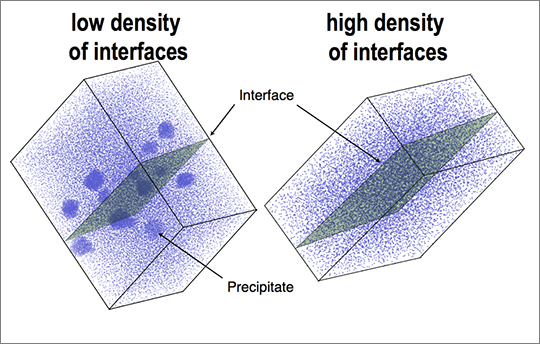
Figure. The suppression of radiation-induced segregation also reduces the propensity of secondary phase precipitation.
The team’s kinetic Monte Carlo (KMC) model incorporates both thermodynamic driving forces and kinetic coefficients, factoring in atomic interactions, defect migration, and entropic effects within an iron-chromium (Fe-Cr) system. It has proven successful for studying precipitation kinetics and for reproducing the dependence of Cr concentration profiles under irradiation, compared with systematic experimental studies available in the literature. The researchers also derived a general analytical model and assessed it against the KMC simulations to clarify the structure-property relationship of this system. The study demonstrated that (in the kinetic regime where elimination of point defects at sinks is dominant over bulk recombination) the segregation of solutes depends not on the dose rate but on the density of sinks. The analytical expressions derived in this work could be applied to other multicomponent systems after determining the material-specific transport coefficients.
Reference: “Role of Sink Density in Nonequilibrium Chemical Redistribution in Alloys,” Physical Review Letters 120, 106101 (2018); doi: 10.1103/PhysRevLett.120.106101. Researchers: Enrique Martínez, Alfredo Caro, and Blas P. Uberuaga (Materials Science in Radiation and Dynamics Extremes, MST-8); and Oriane Senninger, Frédéric Soisson, and Maylise Nastar. (French Alternative Energies and Atomic Energy Commission).
The Laboratory Directed Research and Development (LDRD) program funded the work. The DOE Office of Nuclear Energy’s Nuclear Energy Advanced Modeling and Simulation program sponsored some aspects of the theoretical developments, and the Lab’s Institutional Computing Program provided resources. The research supports the Laboratory’s Energy Security mission area and its Materials for the Future science pillar by improving understanding of the role a material’s microstructure plays in controlling and predicting a material’s functionality. The application indicates a path to mitigate the damaging effects of irradiation in materials used for nuclear energy systems. Technical contact: Enrique Martinez Saez
Mesoscale Materials Science on the Roadmap to MaRIE
X-ray laser provides atomic-level observations of material deformation during high-pressure shock loading
Pressure-driven shock waves in solid materials cause extreme damage and deformation. Understanding that damage is important to phenomena including planetary formation, asteroid impact sites, spacecraft shielding, and ballistic penetrators. However, studies of crystal lattice-level plastic deformation are complicated by the limits of post-shock analysis and modest pressures of less than 100 GPa. In situ x-ray diffraction measurements can help explain a material’s dynamic behavior but have only recently been applied to plasticity during shock compression and until now have not provided detailed insight into competing deformation mechanisms.
Researchers used the Matter in Extreme Conditions (MEC) end-station at the Linac Coherent Light Source (LCLS), SLAC National Accelerator Laboratory to perform x-ray diffraction experiments with femtosecond resolution on shocked polycrystalline tantalum. The work captured, for the first time, in situ lattice-level information that quantifies the contributions of the competing microstructural processes of dislocation slip and twinning during shock-wave-driven deformation. The technique will be useful for studying shock waves and other high-strain-rate phenomena, as well as a broad range of processes induced by plasticity. The journal Nature published the findings.
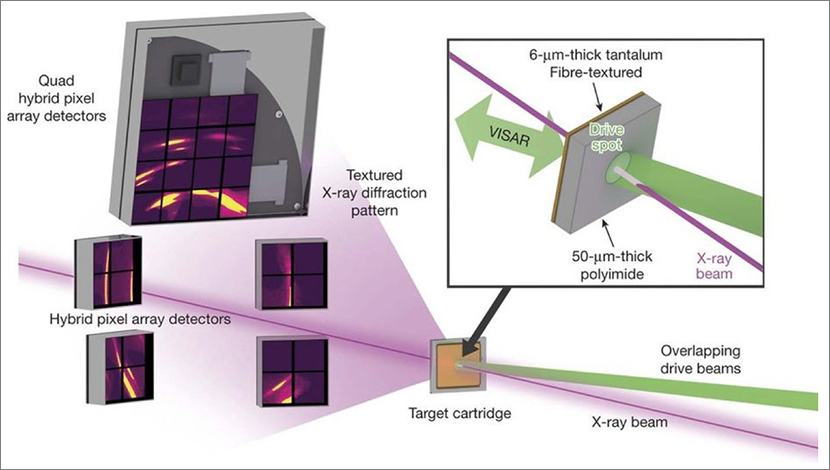
Figure. Laser ablation (green beams) drives a shock wave into the target. The shock-compressed tantalum is probed by the x-ray beam (purple), and the resulting textured diffraction patterns are collected on hybrid pixel array detectors.
The publication described twinning and related lattice rotation that occurred on the timescale of tens of picoseconds. Despite the common attribution of deformation under strong shock to twinning, the data showed that the material’s dominant deformation mechanism changed to dislocation-slip mediated plasticity at more than 150 GPa, or about 1.5 million times atmospheric pressure, which is a regime that recovery experiments cannot accurately access.
The experiment occurred on timescales similar to those probed by molecular dynamics simulations at high-pressure regimes. The timescales enable direct comparison of lattice level simulation and experimental results on commensurate length and time scales in an unprecedented manner, f highlighting the transformative insights to materials under extreme conditions provided by in situ measurements using x-ray lasers.
Combining ultrafast light pulses with atomic resolution, next-generation light sources such as the LCLS allow researchers to explore the mesoscale, the “middle” scale where imperfections, defects, and heterogeneities are critical to controlling macroscopic behaviors and properties.
The experiment is an example of science that could be further advanced with MaRIE, the Lab’s proposed Matter-Radiation Interactions in Extremes capability for time-dependent materials science at the mesoscale. MaRIE aims to provide multiple x-ray measurements per experiment to record the time evolution of deformation processes and to simultaneously bring to bear other particle probes, such as electrons or protons, that sample very different material volumes.
Reference: “In situ X-ray Diffraction Measurement of Shock-Wave-Driven Twinning and Lattice Dynamics,” Nature 550, 496 (2017); doi: 10.1038/nature2406, Researchers: C. E. Wehrenberg, A. Lazicki, H.S. Park, B.A.Remington, R. E. Rudd, D. Swift, and L. Zepeda-Ruiz (Lawrence Livermore National Laboratory); D. McGonegle, M. Sliwa, M. Suggit, and J. S. Wark (University of Oxford, UK); Cindy Bolme (Shock and Detonation Physics, M-9); A. Higginbotham (University of York); and H. J. Lee, B. Nagler, and F. Tavella (SLAC).
The work was funded by the Department of Energy: NNSA Science Campaign 2 sponsored the Los Alamos research, DOE Office of Basic Energy Sciences supported the LCLS at the SLAC National Accelerator Laboratory, and the DOE Office of Fusion Energy Sciences funded the MEC instrument. The research supports the Los Alamos’s Nuclear Deterrence mission area and its Nuclear and Particle Futures science pillar via the study of materials deformation under dynamic shock conditions. The team intends to use these experimental techniques in conjunction with work at Lawrence Livermore National Laboratory’s National Ignition Facility to study such phenomena at higher pressures. Technical contact: Cindy Bolme
Nuclear Engineering and Nonproliferation
Lighthouse Directional Radiation Detectors developed
Lighthouse Detectors are a broad class of directional radiation detectors that use differential attenuation to reveal the vector components of a radiation field. The name Lighthouse Detector comes from the moving field of view, scanning through a solid angle similar to the beam of light emitted from a lighthouse. In practice, these simple detectors function much like an old-fashioned TV antenna, producing a peak measurement when the detector is pointed at a radiation source.
The Lighthouse Detectors allow radiation to enter unattenuated through a particular field of view. Attenuating material either blocks or partially blocks radiation entering from outside this field of view. When the unattenuated field of view is lined up with a radiation source, the detector produces a maximum signal. When the detector is turned so the attenuator is between the detector and the source, the detector’s signal goes down. By adjusting the geometry of the attenuating screen, the detectors can have variable fields of view. Directional accuracy of better than 1 degree has been achieved in laboratory demonstrations. By using advanced materials, attenuation of as much as 50:1 has been achieved using lightweight, hand-held detectors.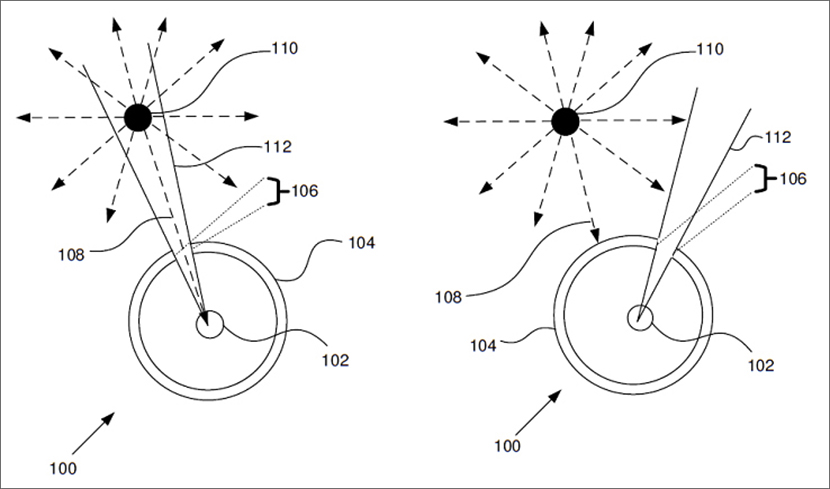
Figure. Schematic of the conceptual operation of a Lighthouse Detector. On the left, a radiation detector (102) receives radiation (108) from a radiation source (110) within the detector’s view frustum (112) through an aperture (106) in an attenuator (104). On the right, the aperture is aimed away from the source, so the source is outside the detector’s view frustum and radiation strikes the attenuator before reaching the detector.
The research team has also built gamma, thermal-neutron, and fast-neutron Lighthouse Detectors. Unlike other types of detectors, the LANL Fast-Neutron Lighthouse Detector achieves directional measurement independent of the scattering inherent in fast-neutron moderation. Unlike pinhole gamma-ray cameras, Lighthouse Detectors have a wide aperture for fast exposure and rapid assay. A wide aperture allows the Detectors to work even in radiation fields having low flux.
In partnership with Quaesta Instruments, LANL scientists miniaturized its Gamma Lighthouse Detector through a Cooperative Research and Development Agreement (CRADA). This instrument features improved noise floor with silicon photomultiplier electronics, power over Ethernet for unlimited operation in remote locations, digital interface for customizable software control, and a built-in web server for data access using only a laptop with a web browser.
Directional radiation measurements are useful for identifying the locations and movements of radioactive materials. The Detectors’ directionality, speed, and sensitivity afford applications in site survey, assay, inventory, security, situation awareness, process controls, and materials control and accountability (MC&A). Directional measurements can verify the location of materials in storage, indicate the movements of materials through portals and along paths, verify the quantities of materials in containers or in use, activate alarms when materials are moved into prohibited areas, and even reveal the locations of contaminants at waste sites. The invention can also verify that an area is free of radioactive materials.
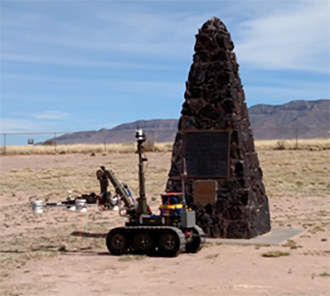
Figure. A radio-controlled HAZMAT Robot with an array of Lighthouse Detectors surveyed the Trinity nuclear test site. Photo credit: Brian Bingamon (Technology Services and Solutions, XIT-TSS)
The team has demonstrated Lighthouse Detectors in several field applications. The Laboratory’s Emergency Response group has installed Gamma Lighthouse Detectors on its HAZMAT robots. This robot can survey field sites without requiring personnel to enter those sites, permitting isotopic-survey and radiation-field measurements while minimizing personnel exposure to radiation. A demonstration at the Trinity nuclear test site showed emergency responder capabilities in operation. Earth System Observations (EES-14) uses the Gamma Lighthouse Detectors for geologic surveys across northern New Mexico, and the Nuclear Materials Science group uses Thermal-Neutron Lighthouse Detectors in research for inventory and measurement applications.
The team currently has a portfolio of five projects and has also developed software to support the technology. The custom software includes data-acquisition modules for Quaesta gamma and neutron systems, and geographic-information-system mapping modules for site-survey applications. In partnership with Phoenix International Holdings and the Sexton Corporation, the Lab is developing Lighthouse Detector sensor systems to survey radioactive materials in the oceans. More information: https://youtu.be/-R-dupdJdKY
The research team includes: L. Jonathan Dowell (International Threat Reduction, NEN-3), Dale Talbott (Technology Development, Q-18), Rick Rasmussen, Rick Rothrock, Sam Salazar, and Theresa Cutler (Advanced Nuclear Technology, NEN-2); Kris Hyatt (Weapons Test Engineering, Q-14); Don Hyatt (High Explosives & Weapons Engineering Tritium Facility, WFO-WETF); Larry Bronisz and James Thompson (Mechanical and Thermal Engineering, AET-1); Chris Chen (Fabrication Manufacturing Science, SIGMA-1); David Fontaine (Laboratory Fabrication Services, PF-LFS); James Hemsing (former student in NEN-2); Gary Sundby (retired from the Lab); Paul Asare Agyapong (U.S. Army); Pete Shifflett, Steve Hamann, David Allen, Gary Womack, Kristopher Savage, and Aaron Clark (Quaesta Instruments, LLC); Peter McKibbin, Dan Pol, Gino Gonzalvez, Robert Lohe, John McCosker, and Juan Sevillano (Phoenix International Holdings, Inc.); Jeremy Childress and Kent Fletcher (Sexton Corporation).
NNSA funded the research, which builds on the Lab’s 75 years of expertise in radiation detection and measurement. The invention supports Los Alamos’s Global Security mission area and the Science of Signatures and Nuclear and Particle Futures pillars. The survey, assay, and inventory for radioactive materials are important capabilities for global security objectives. The research uses the physics and engineering of radiation science, and the signatures characteristic of radioactive materials for detection and estimation, to provide these capabilities. These elements are the foundation of the Science of Signatures and Nuclear and Particle Futures Pillars. Technical contact: Jonathan Dowell
Physics
Single, unifying Pu-239 capture cross section measurement made in the keV - MeV regime
A measurement and modeling campaign has yielded a new evaluation of the neutron capture cross section of plutonium-239 (239Pu), which revealed significant changes relative to past work. A Los Alamos National Laboratory/Lawrence Livermore National Laboratory collaboration used the Detector for Advanced Neutron Capture Experiments (DANCE) at the Los Alamos Neutron Science Center (LANSCE) to execute two different experiments to measure the cross section directly. A reaction theory effort in the Nuclear and Particle Physics, Astrophysics and Cosmology group (T-2) at Los Alamos incorporated past DANCE results on the underlying nuclear structure present in nearby actinides to improve its predictions. The journal Physical Review C published the combined work, and the data have been incorporated into the newly-released Evaluated Nuclear Data File ENDF/B-VIII.0. This new result supported a change in the evaluation for 239Pu fission that directly impacts yield and criticality for nuclear technology applications.
Neutron capture is the result of an incoming neutron being absorbed by the target nucleus, resulting in the emission of gamma-rays. Neutron capture competes with other reactions with two main effects. 1) Capture steals neutrons which otherwise could contribute to energy production. 2) capture transmutes material which ultimately can change isotopic abundances of a given material in the final debris. Therefore, the capture reaction can both perturb performance and potentially provide radiochemical diagnostics.
Part of LANSCE’s science mission is to deliver improved neutron capture cross sections. Fissile nuclei like 239Pu present a particular challenge to the experimentalist because neutron-induced fission produces gamma-rays which contaminate the observed capture gamma-ray spectrum and introduce a significant source of background. This issue is particularly relevant in the keV to MeV regime, where the capture cross section turns off while the fission cross section remains strong.
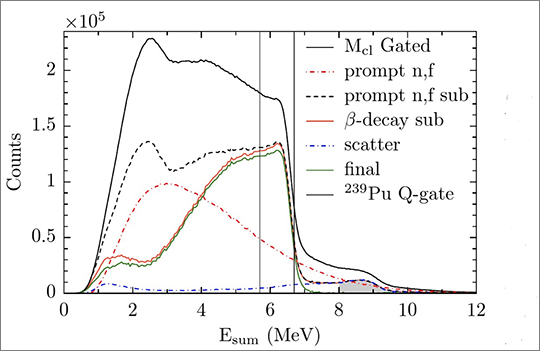
Figure. Example total gamma-ray spectrum and background subtraction process used in the DANCE measurement
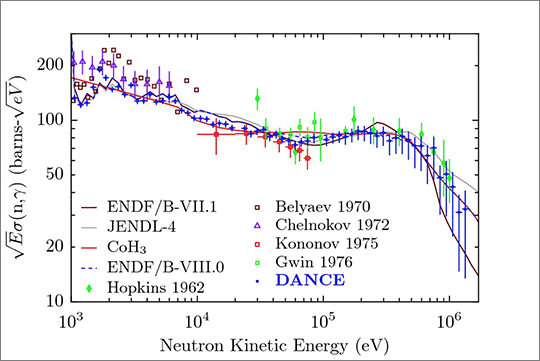
Figure. DANCE cross-section results compared to prior experiment, evaluation, and prediction. The CoH3 curve incorporates prior DANCE results on the nuclear structure of nearby actinides and is consistent with the new experimental results. The newly released ENDF/B-VIII.0 incorporates this result into the new evaluated cross section.
The team used two different experimental configurations of DANCE to characterize the fission background and obtain counting statistics at the highest incident neutron energies. The Figure shows DANCE’s unique ability to characterize and eliminate background by looking at the total gamma-ray energy released in a physics event of 239Pu(η,ϒ). Each line represents a unique background which DANCE characterized and subtracted in order to improve the final capture result. The difference between the black and green lines are the backgrounds that must be eliminated.
The individual lines represent individual parts of the background characterization and subtraction process. The granularity of information greatly improves confidence in the final uncertainty budget compared with prior work. DANCE successfully reported a capture measurement extending from 1 keV to 1.3 MeV, the highest incident neutron energy reported by DANCE to date.
The Figure shows the state of data and evaluation before and after the DANCE campaign. The LANSCE neutron source uniquely produced all neutron energies simultaneously, enabling cross-section shape measurement across the keV to MeV range. Past experiments each only measured a subset of that range with generally small or discrepant overlap regions, presenting additional challenges stitching together an overall evaluation. The DANCE data resolve this issue.
Above 0.5 MeV, evaluations differed dramatically. The DANCE results are consistent with the low edge of prior experiments’ confidence band and suggest a cross section between ENDF/B-VII.1 and JENDL-4. New predictions using the CoH3 code including prior DANCE results for nuclear structure on the nearby uranium nuclei are consistent with the direct DANCE cross-section measurement. The newly released ENDF/B-VIII.0 has adopted by the CoH3 prediction at the highest incident neutron energies. The results guide future development toward reducing uncertainty above 0.5 MeV. The ongoing Lujan target redesign will enable experimental optimizations that will directly improve DANCE’s achievable uncertainty in this region.
Reference: “Unifying Measurement of 239Pu(η,ϒ) in the keV to MeV Energy Regime,” Physical Review C 97, 041601 (R) (2018); doi: 10.1103/PhysRevC.97.041601. Authors: Shea Mosby, Aaron Couture, and John Ullman (LANSCE Weapons Physics, P-27); Todd Bredeweg (Nuclear and Radiochemistry, C-NR); Marian Jandel (C-NR/University of Massachusetts - Lowell); Toshihiko Kawano (Nuclear and Particle Physics, Astrophysics, and Cosmology, T-2); Roger Henderson and Ching-Yen Wu (Lawrence Livermore National Laboratory).
DOE/NNSA Science Programs (Campaigns 1 and 4, Laboratory Program Managers Ray Tolar and Melissa Douglas) funded this research. The work supports the Lab’s Nuclear Deterrence and mission area and the Nuclear and Particle Futures science pillar, particularly the applied nuclear science and engineering thrust goal of measuring and predicting nuclear reaction rates. Improved nuclear data libraries also support reactor design in the Lab’s Energy Security mission area. Technical contact: Shea Mosby
Sigma
Transparent polycrystalline Gd3TaO7 ceramics developed
Gd3TaO7 is an optical ceramic with scintillator applications. It is one of a small number of ceramics that has infrared transmission extending well beyond the mid-wave infrared (3-5 –mm). The transparent ceramic of this material provides high density and high effective Z, which are desirable properties for a host lattice for scintillators. In order to serve as a scintillator, a material must have high optical transparency so that the scintillating light can be transmitted through the scintillator and reach the photomultiplier tubes or other detectors. One of the critical requirements for achieving high optical transparency is a fully dense sample so that residual pores are not present to scatter the scintillating light. Los Alamos researchers collaborated with J.A. Woollam Co., Inc., Lawrence Livermore National Laboratory, and Colorado School of Mines to develop developed transparent polycrystalline Gd3TaO7 ceramics with high density, high effective Z, high in-line transmission, and high refractive indices. The Journal of the American Ceramic Society published their research.
Gd3TaO7 is also one of a relatively small number of ceramics that has infrared (IR) transmission extending well beyond the mid-wave infrared (MWIR) (3 to 5 μm). For radome (structure protecting radar equipment) applications, for example, high transmittance out to 5 μm wavelength and beyond is important both to maximize signal transmission and to minimize noise from hot dome emission.
Researchers developed a sol-gel process to synthesize Gd3TaO7 powder with a uniform composition and an estimated average particle size of 100 nm. Crystallization was confirmed by x-ray diffraction (XRD) and a single phase was achieved by calcining at 1000°C. The calcined powders were hot-pressed at 1400 °C to achieve >96% theoretical density with closed pore structure followed by a hot isostatic pressing at 1400 °C at 207 MPa to achieve a fully dense structure. Figure 1 is a picture demonstrating the visible image with the sample lifted by about 1 inch. The sample was processed from sol-gel powder synthesis followed by hot-pressing and hot-isostatic pressing. Figure 2 is an electron backscattering diffraction micrograph showing a fully dense structure with a uniform grain size distribution. The in-line transmission of transparent polycrystalline Gd3TaO7 as a function of wavelength demonstrated shows a high transmission between the 3 to 5 micron range.
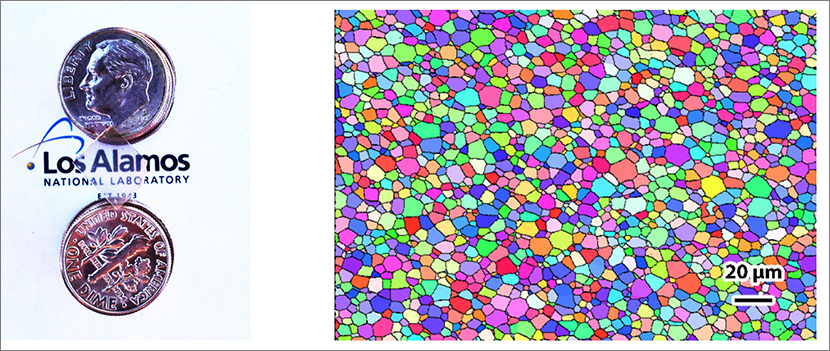
Figure. (Left): The photo demonstrates the transparency of the fully dense, single phase polycrystalline ceramic. The sample was lifted by about 1 inch above the text. (Right): An electron backscattering diffraction micrograph reveals a fully dense structure with a uniform grain size distribution.
Reference: “Processing and Characteristics of Transparent Gd3TaO7 Polycrystalline Ceramics,” Journal of the American Ceramic Society 101, 1847 (2018); doi: 10.1111/jace.15359. Authors: C.-F. Chen and M. J. Brand (Fabrication Manufacturing Science, Sigma-1), R. A. Synowicki (J.A. Woolam Co.), E. L. Tegtmeier and J. D. Montalvo (Finishing Manufacturing Science, Sigma-2), J. Ivy and G. L. Brennecka (Colorado School of Mines), Z. Seeley, N. J. Cherepy, and S. A. Payne (Lawrence Livermore National Laboratory).
NNSA NA-22 funded the research, which supports the Laboratory’s Global Security mission area and Materials for the Future science pillar through development of materials for potential use in scintillators, infrared, and other optical applications. Technical contact: Chris Chen





